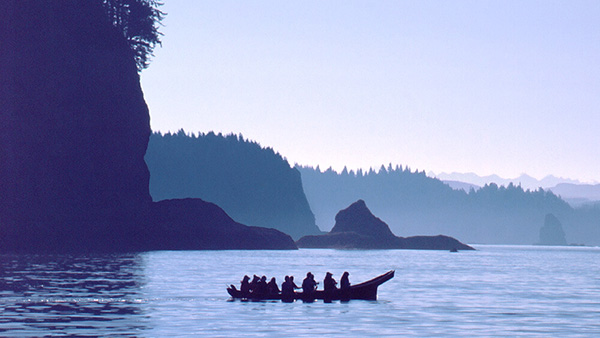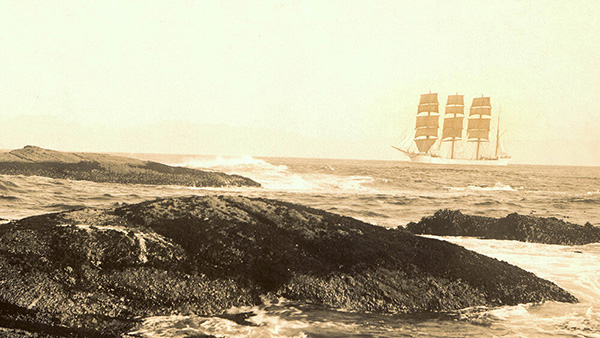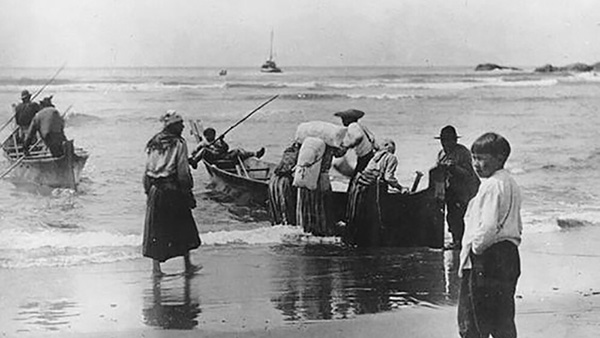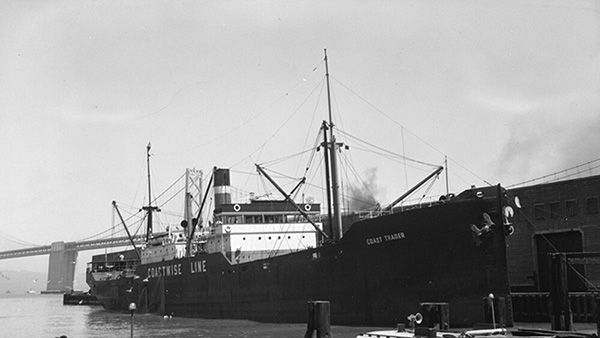European Colonial Period
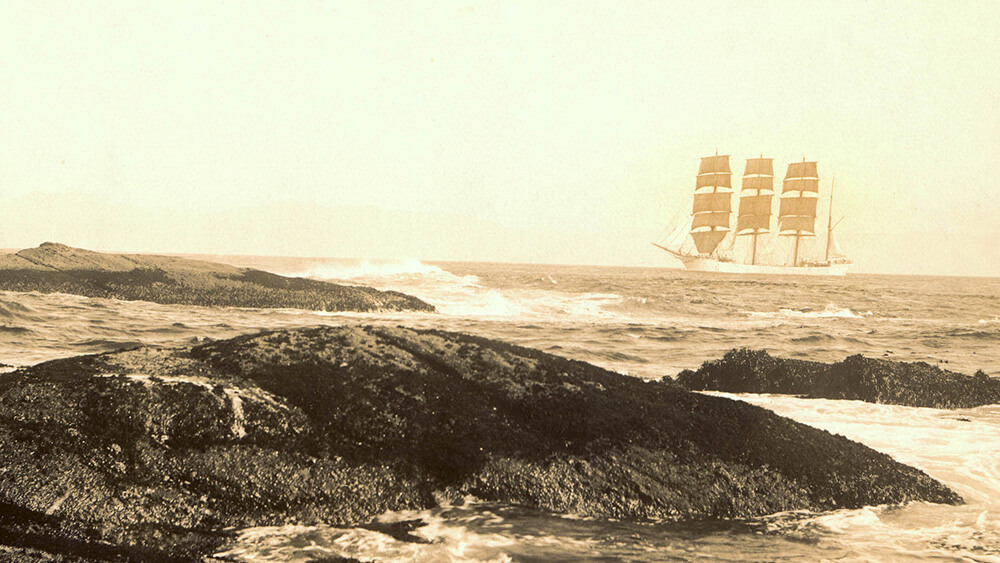
The Spanish first explored the Pacific coast in the 16th century. After his 1592 expedition to the region, Juan de Fuca’s name became associated with the strait that separates Canada and the U.S. However, it is unclear whether he ever saw the body of water himself. The Spanish did not attempt to exert influence over the area until the late 18th century. In fear of Russian and English fur traders’ incursions into their claimed territories, the Spanish belatedly sought to secure their own claims on western North America.
The first recorded European contact with the coastal Native Americans was between the Spanish explorers Bruno Heceta and Don Juan Francisco de la Bodega y Quadra in 1775. They were quickly followed by other Europeans, and later Americans, all hoping to capitalize on the sea otter and fur seal trade. Other ship-bound Europeans and Americans followed as westerners spread out along the western North American coastline to hunt seals, otters, and whales. American contact was disastrous for the Native Americans, resulting in the decimation of Indigenous populations from disease. By 1855 most of the tribes were consigned to reservations by the U.S. government.
During Captain James Cook’s 1778 expedition to the region, sailors traded cheap trinkets to the natives in exchange for otter pelts. Accounts of vast profits made selling the pelts to the Chinese at Canton (later in their voyage) tipped off European and American business interests that there was a potential value to exploiting that trade. Merchant ships from the east quickly converged on the Northwest Coast.
Spain negotiated to share the Northwest with Great Britain and attempted to set a boundary by placing a settlement at Neah Bay. The Spanish, however, did not have sufficient strength to maintain the region against mounting foreign incursions. The Spanish, after only six months, abandoned the Neah Bay settlement. American traders swarmed into the area to challenge Britain’s perceived hegemony and to trade with the tribes for otter pelts. As the English established a permanent presence on the north shore of the strait in British Columbia, the Americans claimed primacy south of the Strait of Juan de Fuca.
Maritime Fur Trade
The official account of Captain James Cook’s expedition to the Pacific Northwest described the value of the potential fur trade. This attracted European entrepreneurs to waters of the Pacific Northwest. At the same time that British and American traders entered the trade, Russian hunting was expanding to the south. Between 1803 and 1846, 72 American ships were involved in the otter hunt in California, harvesting an estimated 40,000 skins and tails, compared to only 13 ships of the Russian-American Company, which reported 5,696 otter skins taken between 1806 and 1846. In 1812, the Russians founded an agricultural settlement at what is now Fort Ross in Northern California, as their southern headquarters. Eventually, sea otter populations became so depleted, commercial hunting was no longer viable. It had stopped in the Aleutian Islands, by 1808, as a conservation measure imposed by the Russian-American Company. Further restrictions were ordered by the company in 1834. When Russia sold Alaska to the United States in 1867, the Alaskan population had recovered to over 100,000, but Americans resumed hunting and quickly extirpated the sea otter again. Prices rose as the species became rare. During the 1880s, a pelt brought $105 to $165 in the London market, but by 1903, a pelt could be worth as much as $1,125. In 1911, Russia, Japan, Great Britain (for Canada), and the United States signed the Treaty for the Preservation and Protection of Fur Seals, imposing a moratorium on the harvesting of sea otters. So few remained, perhaps only 1,000–2,000 individuals in the wild, that many believed the species would become extinct.
What started with Captain Cook trading sea otter pelts to China in 1778, came to an end in 1910 when the last recorded sea otter in Washington was killed. The following year Russia, Japan, England, and the United States signed the treaty banning the taking of sea otters and fur seals. By that time the otters had been extirpated from nearly their entire range. A few remnant populations survived in remote locations on the Kamchatka coast, in the Aleutian and Commander Islands, and in Prince William Sound. Under protection of the treaty, they began a comeback.
In 1969 and 1970, in an effort to mitigate the effects of U.S. military nuclear weapons testing, 59 otters were moved from Amchitka Island in Alaska to areas along the Washington coast near La Push. It is estimated that the current Washington coast sea otter populations are descended from as few as 10 of these animals. A 2021 survey of the Washington coast estimated the population to be 1,811 sea otters.
Competing Claims for European Powers
At the start of the 19th century, there were conflicting claims in the Pacific Northwest. First and foremost, it is important to remember that these were settled lands. While European powers maneuvered to exert claims and influence, Indigenous people went about their own lives interacting with traders on their own terms. The primary players were initially the Russian Empire, the United Kingdom, and the Kingdom of Spain.
On October 20, 1818, in order to improve relations in the wake of the War of 1812, the United Kingdom and the United States agreed to peaceful coexistence in the Pacific Northwest by signing the Convention of 1818 (also known as the Treaty of Joint Occupation) in London. Under the treaty a large area, including the Olympic Coast, was considered to be free and open for a period of 10 years. The treaty restrained both nations from seeking unfair advantage through accelerated settlement of the area, which was then dominated by the Hudson Bay Company.
The following year, the Transcontinental Treaty of 1819 was signed by the United States and Spain, with Spain ceding Florida to the U.S. and defining the boundary between the U.S. and New Spain. It settled a standing border dispute between the two countries and was considered a triumph of American diplomacy. The treaty established the boundary of U.S. territory and claims through the Rocky Mountains and west to the Pacific Ocean. This left the United States and the United Kingdom as the primary non-indigenous players in the region.
In 1838 the United States Navy assembled a fleet of ships for a voyage of exploration in the Pacific Ocean. The U.S. Exploration Expedition, or Ex. Ex., led by Lieutenant Wilkes, sailed in Washington waters in 1841. Their efforts supported the United States’ claim to the area during future negotiations with the United Kingdom. The United States took a more aggressive posture after the Wilkes expedition of 1841. Rebellious American settlers in Oregon declared a provisional government in 1843, and some American politicians, using the slogan "Fifty-four Forty or Fight," argued that the American boundary should extend all the way to the latitude line of 54 degrees, 40 minutes, then the southern boundary of Russian Alaska. The British disagreed, and America chose not to fight. In the 1846 Treaty of Oregon, the two nations compromised by establishing the 49th parallel, already the U.S.-Canada border east of the Rockies, as the boundary in the mainland Pacific Northwest.


